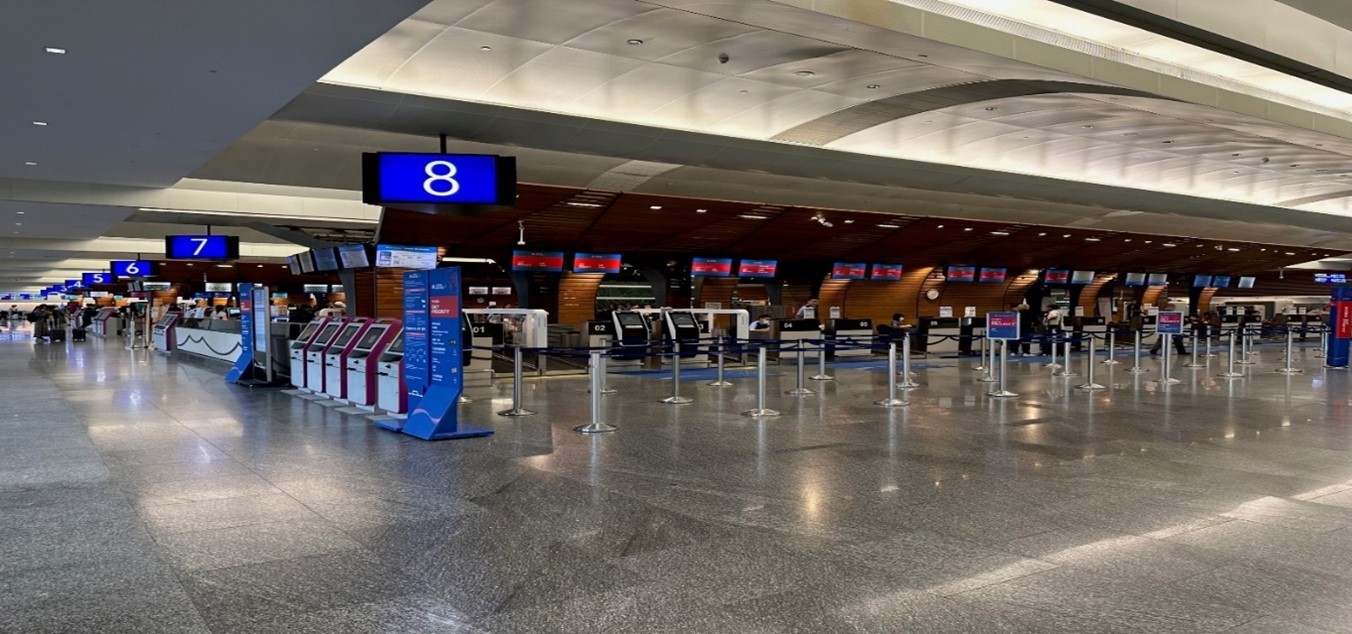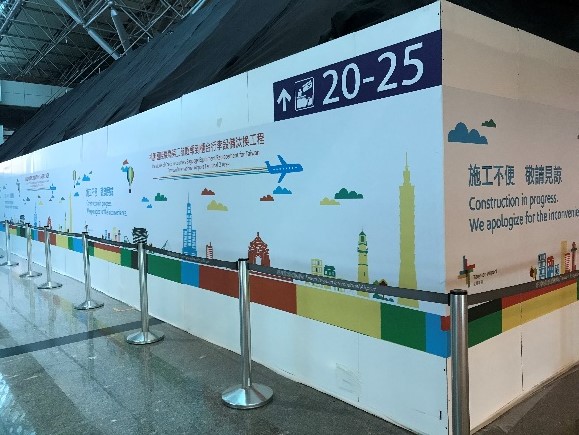Eco-friendly Innovation
綠色創新
Applying Smart Self-Service Bag Drop System to Improve Airport Service Quality
Self-service bag drop (SBD) systems at the airports are becoming increasingly common. Not only do they help reduce check-in time for passengers, but can also help reduce manpower and increase work efficiency for airline companies. In this article, we will talk about the Taoyuan International Airport Terminal 1 Self-Service Bag Drop project that was undertaken by CTCI Advanced Systems Inc. (CTCI ASI), an affiliate of CTCI Group, explaining how the project helps Taoyuan Airport come a step closer to becoming a smart airport while achieving energy conservation and carbon emissions reduction.
Project Background
SBD systems have already been partially adopted by Taoyuan International Airport (Taoyuan Airport). The first SBD counter was set up at the Airport MRT A1 Station (Taipei Main Station), which is used in conjunction with the airport's early arrival baggage storage area for passengers to store their baggage. Subsequently, more SBD counters have been installed at the Airport MRT A3 Station and Taoyuan Airport Terminal 2. With rich experience in baggage handling systems and baggage reconciliation systems, CTCI ASI continues to gain business opportunities by helping airports improve baggage transferring.
In this project, CTCI ASI’s task is to build a new and complete set of SBD installations and complex check-in belt conveyors at Taoyuan Airport Terminal 1 to meet the airport’s business needs. Comprised of primarily short-haul routes, the majority of which are operated by China Airlines, Cathay Pacific, and Tigerair Taiwan, Terminal 1 used to have as many as 40 airlines in simultaneous operation which shared 12 check-in counter lines before Covid-19. Back then, early morning was the peak time for passenger check-in, with more than 2,000 pieces of checked baggage. Through this project, CTCI ASI helped the airport authority increase the baggage handling volume, as well as improve the counter scheduling, traffic efficiency, and passenger check-in and customs clearance experience. CTCI ASI also aimed to achieve five goals during the implementation period (February 2022 - January 2024): Utilize innovative and smart means to improve the passenger check-in process; help passengers save time when checking in their baggage; gradually turn the check-in counters into counters for common use; reduce the ground staff’s chances of getting baggage-handling injury; and strengthen disease control measures. These five goals are evidence of CTCI ASI’s sustainable development efforts.
User-Friendly Designs That Meet Various Needs
CTCI ASI installed 192 outbound passenger check-in counters and 180 sets of baggage conveyors. Among all check-in counters, 30 of them are hybrid counters as they come with SBD features. To allow flexibility for airport facility rearrangement in the future, all check-in counters have the same design features, including the luggage platform and pre-allotted space for future SBD equipment installation, while the type of weighing scale and conveyor is identical across the whole terminal, meaning that the electronic control components and installation positions can be seamlessly integrated with the SBD equipment. Should the airport authority wish to change the location of the hybrid counters in the future, they will only need to relocate the SBD equipment, and there will be no need to remove or replace the counters or conveyor units.
In addition to properly considering the future needs of the owners, the CTCI ASI team is also committed to user-friendly designs to enhance the passengers experience. For example, the sensor and identification components were installed around the weighing scales and conveyors, which would automatically detect the passengers’ luggage operation and guide them through screen images to place their luggage correctly, so as to complete the baggage check-in process. Another example is that the height between the front-end of the weighing conveyor belt and the floor is lowered to 10 cm to make it easier for passengers to place luggage. The height is 50% lower than that of the weighing conveyor in Terminal 2. The last example is the consideration for future scalability by reserving the One ID integration function. In the future, passengers will no longer need to show their passports or boarding passes, as they will use their single biometric identifier instead. The One ID initiative will usher in a more modernized and intelligent airport experience.
The design also considers the operational needs of the airline ground staff. For example, the design of the hybrid check-in counter is based on the design of the manual check-in counter, where the equipment and furniture at the medial of the hybrid counter are the same size and same location as the manual counter. The ground staff would therefore have no need to adapt to new environment, and are able to work and move at ease and unhindered when switching counters.

Creating Best Outcome through Teamwork by the Most Reliable Team
The success of this project drew on the strengths of multiple CTCI companies- CTCI ASI, ECOVE ESC, and CTCI REI- and relied on their collaboration. CTCI ASI, the main contractor, specializes in airport electromechanical engineering, control, and information communication, and is the only company in Taiwan that has professional experience in electronic control and integration for airport passenger baggage handling systems. Given the importance of Taoyuan Airport as the nation’s gateway, CTCI ASI collaborated with ICM Airport Technics, an Australia-based world-leading company in SBD solutions that brought the most advanced equipment and general solutions to the airport and was responsible for the mechanical and electronic control design of all complex belt conveyors in the departure hall. On the other hand, ECOVE ESC, which has decades of expertise and experience in electromechanical system maintenance, was tasked to receive full training from ICM Airport Technics and be responsible for the installation of SBD equipment, as well as the maintenance of conveyors and SBD equipment. Meanwhile, CTCI REI was responsible for the provision of civil, mechanical, and electrical engineering technician services, as well as hiring local partners for construction and furnishing. In addition, as a company that has won 13 Public Construction Golden Quality Awards and 5 Golden Safety Awards, CTCI REI provides guidance to help the team compete for the award. Such collaboration success allows CTCI Group to become the best service team for airport SBD systems in Taiwan and meet the owner’s needs.
Project Challenges and Solutions
To ensure uninterrupted airport operation, minimize the impact of noise, dust and rerouting on passengers, construction work was carried out at night, including the dismantling, installation, and movement of equipment, which all happened within the erected safety fence (as shown below). Despite the occasional complaints that still happen from time to time, which posed as project obstacle in early stage, the project was eventually on schedule- even ahead of schedule- thanks to the CTCI ASI team’s humble attitude towards criticism, its quick review, and the prompt adjustment on a rolling basis.

In addition, CTCI ASI ensured that each passenger check-in counter island goes through a series of comprehensive checks on system connection, system exchange, system simulation, system switching, and integration testing. Once the overall system testing has been completed, trial operations and inspection procedures were carried out as per contract requirement. Only then could all equipment and systems in the island area be available for use by airline companies and passengers. In practice, to allow for sufficient adjustment time, the CTCI ASI team submitted all essential data for review well in advance, and scheduled multiple rounds of comprehensive system testing and rehearsals to mitigate testing risks. This ultimately contributed to a swift and thorough acceptance procedures.
Summary and Outlook
SBD facilities have nowadays become a key airport infrastructure in advanced nations. The multiple benefits associated with SBD systems include: reducing luggage handling injuries to ground staff by installing the complex check-in conveyor belts; user-friendly operation that significantly reduces passenger luggage check-in time (less than 2 minutes to complete check-in with SBD, compared to 3-5 minutes through manual check-in counter); an improved passenger check-in process; and reducing the need for ground staff, thereby strengthening disease control. Additionally, hybrid SBDs can gradually help improve the current situation in Terminal 1 where check-in counters are used by separate airlines exclusively and achieving the vision of common use.
Looking ahead, CTCI Group will remain committed to providing the most reliable engineering services to clients by drawing on the success of this project, as well as by sharpening its expertise in airport baggage conveyor system and other fields.




